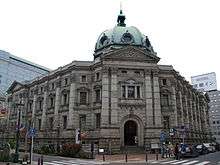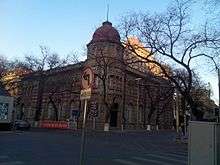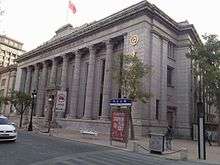Yokohama Specie Bank
Yokohama Specie Bank (横浜正金銀行 Yokohama Shōkin Ginkō) was a Japanese bank founded in Yokohama, Japan in the year 1880. Its assets were transferred to The Bank of Tokyo (now The Bank of Tokyo-Mitsubishi UFJ) in 1946. The bank played a significant role in Japanese trade with China.[1] The original bank building is now the Kanagawa Prefectural Museum of Cultural History. During the Second World War the bank controversially acted as the paymaster for the Imperial Japanese Army as it conquered parts of Asia.

The Yokohama Specie Bank (now The Kanagawa Prefectural Museum of Cultural History)

Kobe branch (now The Kobe City Museum)

Nagasaki branch
Shanghai, China branch

Beijing, China branch

Tianjin, China branch
Dalian, China branch
Honolulu, Hawaii branch
The Yokohama Specie Bank during WWII
History
Institutional
- 1879 – The National Bank Act establishes the Yokohama Specie Bank
- 28 February 1880 – Bank officially opens
- 1882 – YSB begins foreign exchange business
- March 1883 – Rokuro Hara is brought in as president
- 1887 – Yokohama Specie Bank Ordinance, and revision in 1889, establishes the YSB as an exchange bank, subject to stricter control than ordinary banks, but also eligible for support from the government and the Bank of Japan
- 1946 – The Bank of Tokyo is designated to take over the business.
- 1963 – Liquidation
International expansion
- 1880 – YSB establishes an agency in New York
- 1881 – YSB establishes its London sub-branch
- 1884 – The London sub-branch is upgraded to a full branch
- 1893 – YSB opens its Shanghai branch
- 1910 – Honolulu, Hawaii branch opens in a building that the architect Harry Livingston Kerr designed.
Miscellaneous
Past presidents
- First (December 1879 – July 1882) Michita Nakamura
- Second (July 1882 – January 1883) Eisuke Ono (father of Yoko Ono)
- Third (1883 January – March 1883) Hakushu
- Fourth (March 1883 – March 1890) Hara Rokurou
- Fifth (1890 March – April 1897) Yoshi Takashi Sonoda
- Sixth (March 1897 – March 1906) Yin Aiba Hisashi
- Seventh (March 1906 – June 1911) Korekiyo Takahashi
- 8th (March 1911 – February 1913) Yatarō Mishima
- 9th (1913 February to September 1913) Mizumachi
- 10th (September 1913 – March 1919) Junnosuke Inoue[4]
- 11th (March 1919 – March 1922) Kazihara Nakazi
- 12th (March 1922 – September 1936) Kodama Kenzi
- 13th (September 1936 – March 1943) Hori Ken Oohisa
- 14th (March 1943 – June 1945) Hideshige Kashiwagi
- 15th (1945 June–July 1946) Arakawa Shiyouzi
- 16th (1946-June–December 1946), Hee-Ichi Takada
See also
![]()
References
- ↑ The Yokohama Specie Bank Building – built in 1924 (No. 24, The Bund) Archived 12 September 2011 at the Wayback Machine.
- ↑ "The Torpedoed "Hirano Maru"". The Singapore Free Press and Mercantile Advertiser. 13 December 1918. Retrieved 4 January 2012.
- ↑ "独政府を相手に損害賠償の訴え". Osaka Asahi Shinbun. 10 July 1919. Retrieved 4 January 2012.
- ↑ Tamaki, Norio. (1995). Japanese banking: a History, 1859-1959, p. 120, p. 120, at Google Books
External links
Further reading
- Japanese banking: a History, 1859-1959 — by Norio Tamaki
This article is issued from
Wikipedia.
The text is licensed under Creative Commons - Attribution - Sharealike.
Additional terms may apply for the media files.